Canada’s leading Ukrainian-Canadian newspaper, The New Pathway Ukrainian News, published a feature article about CUTIS Project – an initiative of CUCC funded by Global Affairs Canada.
Please find the whole text below.
Update of CUTIS activities in 2018
The Canada-Ukraine Trade and Investment Support (CUTIS) Project is a five-year development assistance project undertaken with the financial support of the Government of Canada (GoC) provided through Global Affairs Canada (GAC), from February 9, 2016 to February 1, 2021.
The CUTIS project aims to increase sustainable economic growth in Ukraine through the expansion of Ukrainian exports to Canada and the encouragement of Canadian investment in Ukraine. In order to increase trade and investment between Canada and Ukraine, the project focuses on supporting Ukrainian small and medium-sized enterprises (SMEs), including SMEs owned or operated by women.
The Canada-Ukraine Chamber of Commerce in coalition with the Conference Board of Canada are partners on the CUTIS project and have been involved since its inception.
To date, CUTIS has partnered with the Ministry of Economic Development and Trade of Ukraine, the Export Promotion Office and UkraineInvest, and works with a wide range of stakeholders, including Ukrainian SMEs in priority industries, government, business associations, other donor-funded development initiatives and think tanks.
CUTIS improved trade information flow by developing a step-by-step guide on how to export from Ukraine to Canada and sharing that critical information with Ukrainian exporters through focus groups, seminars and webinars. The Ukrainian language “I CAN Export Guide” is available on CUTIS website: cutisproject.org. CUTIS project has been promoting the guide on CUTIS’ website, Facebook page, Twitter account, LinkedIn page and YouTube channel.
Trade and Economic Relations between Ukraine and Canada
For the first time since 2014, Ukraine managed to overcome the negative trends in bilateral trade cooperation. The State Statistics Committee of Ukraine data showed that in 2017, bilateral trade between Ukraine and Canada had increased, and the progress was due in part to the Canada-Ukraine Free Trade Agreement, which came into force on August 1, 2017.
According to the State Statistics Committee of Ukraine the total trade turnover between Ukraine and Canada amounted to USD $477.7 million in 2017, export being USD $141.5 million, import – USD $336.2 million. The 2017 data revealed the volume of bilateral trade in services between Ukraine and Canada amounted to USD $128.1 million, the exports of services from Ukraine to Canada being of USD $91.1 million (increased by 18%), and imports of services from Canada to Ukraine of USD $37 million (decreased by 7.5%). The IT sector services dominated export of services from Ukraine to Canada, representing 60.9% of the total. Additionally, as of December 31, 2017, Canadian investments into the Ukrainian economy amounted to USD $49.6 million (as of January 1, 2017 – USD $41.1 million).
Recent Investments by Canadian Companies
In October 2018, French insurer AXA agreed to sell its entire insurance business in Ukraine to Canadian financial services company Fairfax. The Ukrainian insurance business has more than 780 employees, 1,220 agents throughout the country and written premiums of approximately $43 million. In 2015, Fairfax acquired QBE Ukraine another insurance operation, which was later re-branded as Colonnade Ukraine. The purchase price was not disclosed.
In September 2018, Canadian Solar developer TIU Canada broken ground on a new 20.2-hectare solar power system plant boasting a capacity of 13.5 MW in Mykolaiv region, near the village of Kalynivka. In June 2016, TIU had announced a plan to invest USD 111 million in the construction of five solar plants with 90 MW in total capacity. In addition to Kalynivka array, TIU intends to commission two other plants in Mykolaiv and another in the neighbouring region of Kherson. TIU Canada is owned by Refraction Asset Management, based in Calgary, Alberta.
In July 2018, Brookfield Asset Management in conjunction with a group of Lviv based international IT companies have announced their support of the Lviv Innovation District IT Park. The USD 160 million, 10-hectare IT park will include: office buildings, campuses and labs, kindergartens, shopping malls, the Ukrainian Catholic University and other customary facilities. The project will provide office space for nearly 30 IT companies, 14,000 employees and create new jobs.
Trade Shows
CUTIS in conjunction with the Ukrainian government identified five priority trade sectors: Information and Communications Technology, Chocolate and Sugar Confectionery, Apparel, Footwear and Furniture. Based on in-depth market intelligence studies the chosen commodity sectors have the highest probability of successfully exporting to Canada.
In May of 2018, CUTIS launched the brand, Made In Ukraine at SIAL Montreal, the world’s leading international food exhibition network. CUTIS project’s Made In Ukraine row of specialty boutique shops highlighted seven Ukrainian sugar confectionary and chocolate producers to an audience of more than 18,500 buyers, distributers and retailers from Canada, the United States and internationally. The trade show had over 1,000 exhibitors. CUTIS project’s industry experienced consultant contacted, analyzed and interviewed over 41 companies and found that 13 eligible participants, of which seven were chose and exhibited at the Montreal trade show.
CUTIS’s Made In Ukraine – MEBLICA, at the Canadian Furniture Show featured two open-concept living spaces designed by Sergey Makhno Architects and was furnished by 10 unique and superior quality Ukrainian manufacturers. Made In Ukraine’s high caliber showcase of furnishings won the attention of the 4 industry professional judges and garnered the Best New Exhibitor, 2018 Canadian Furniture Show, and the KULIK System chair was selected by showcase designer and featured in the TRENDS Showcase. The CUTIS project initially had 58 furniture company applicants, 37 were trade eligible and 10 companies participated at the furniture show. The Canadian Furniture Show is the largest furniture trade show in Canada and had over 200 exhibitors and more than 7,000 trade industry visitors.
In August, eight Ukrainian clothing manufacturers launched at the Apparel Textile Sourcing Canada show, featuring lifestyle fashionable urban wear, sportswear and loads of casual comfortable pieces. Simultaneously, eight Ukrainian footwear manufacturers participated at the Toronto Shoe Show and plied their wares from the boutique shops on Ukrainian Avenue. Made In Ukraine introduced stylish shoe brands, quality urban fashions combined with cutting-edge European technology. These perfect venues introduced and opened the door for new business opportunities connecting Ukrainian manufacturers and producers with independent and major retail buyers at business to business (B2B) meetings.
The CUTIS team met with and analysed over 30 apparel companies, determined 15 eligible participants of which eight manufacturers joined the Apparel Textile Sourcing Canada show. The trade show had over 600 exhibitors and more than 5,000 attendees. The footwear industry consultant and CUTIS team met and interviewed 15 shoe producers and selected eight for the Toronto Shoe Show. The show had over 20,000 visitors and more than over 500 exhibitors.
Made In Ukraine, had the trade shows fully covered and offered a winning combination. Top quality, state of the art technology complemented by Ukrainian skilled craftsmanship and competitive pricing backed by the Canada-Ukraine Free Trade Agreement (CUFTA), placing Made In Ukraine in a unique category. The CUFTA entered into force on August 1, 2017 immediately eliminates tariffs on 99% of current imports from Ukraine and contains commitments related to trade facilitation designed to reduce red tape at the border.
Investment Activity
CUTIS project is right on track, looking ahead and planning for the future. October was all about business and finance, and opportunities for decision makers to interact from both sides of the commercial and geopolitical coin. CUTIS celebrated the first anniversary of the Canada-Ukraine Free Trade Agreement (CUFTA) at the Design Exchange and kicked off the first ever Investment Roadshow. The key note speaker at the evening soiree was Stepan Kubiv, First Vice Prime Minister of Ukraine and Minister of Economic Development and Trade, and the special guests included Canadian government representatives, as well as 17 Ukrainian deputy ministers, members of parliament and embassy staff.
The two-day Investment Roadshow was held at The Albany Club where 21 pre-selected Ukrainian companies and C-level management presented to high net worth and institutional Canadian investors lucrative projects in four major sectors: Infrastructure, Natural Resources, Agriculture, and Information & Communications Technology for an estimated total value of USD 1.5 billion dollars. Over 200 prospective Canadian investors attended the opening reception and the two-day Investment Roadshow.
The following week, CUTIS hosted an Executive Roundtable with Dmytro Sologub, Deputy Governor, National Bank of Ukraine and 15 Canadian executives from commercial and investment banks, and insurance and investment companies. Along with a lively round-table discussion, Dmytro Sologub’s presentation provided a better understanding of the National Bank of Ukraine’s interest-rate and economic strategies for the next two years.
In early fall it was back to school and time for Training of Trainers. For a two-week period, fifteen Ukrainian Regional Chambers of Commerce representatives and business schools were trained in Ukraine, Ottawa and Toronto, and put through their paces on how to disseminate information to Ukrainian SME’s (small or medium-sized enterprises) about how to export to Canada.
Future Plans
CUTIS project is planning a second round of trade shows with the Ukrainian footwear manufacturers in February 2019 and chocolate and confectionary producers in May 2019. In addition, over 15 ICT companies will be arriving in Toronto in March 2019 to hold B2B meetings with developers, distributors and potential partners for their products and services.
The Honourable Chrystia Freeland, Minister of Foreign Affairs, agreed to host the Ukraine Reform Conference, Summer 2019. The 2019 conference will bring together foreign ministers from the European Union, the G7 and NATO countries to support Ukraine in ongoing democratic and economic reforms. Canada is firmly committed to working with the international community to support Ukraine and work toward a secure, sovereign and prosperous future for the people of Ukraine. At last year’s conference, hosted by Denmark, discussions were held about recent key reform developments, such as the passing of the Higher Anti-Corruption Court law. CUTIS is expecting to participate, and highlight select Ukraine’s companies’ products and services during the conference which will be held in Toronto.
CUTIS is looking forward to seeing trade and investments between Ukraine and Canada increase significantly in 2019 and 2020.
Bohdan Leshchyshen, Canadian Project Director, CUTIS Project










 (вихідних для промисловості) на суму $1,9 млрд, експортувала – на $2,1млрд. Для порівняння – до Канади за 2015 рік імпорт з України тих самих проміжних товарів склав $9,4 млн, а експорт – $17,6 млн.
(вихідних для промисловості) на суму $1,9 млрд, експортувала – на $2,1млрд. Для порівняння – до Канади за 2015 рік імпорт з України тих самих проміжних товарів склав $9,4 млн, а експорт – $17,6 млн.
 Автор: Степан Кубів,
Автор: Степан Кубів,
